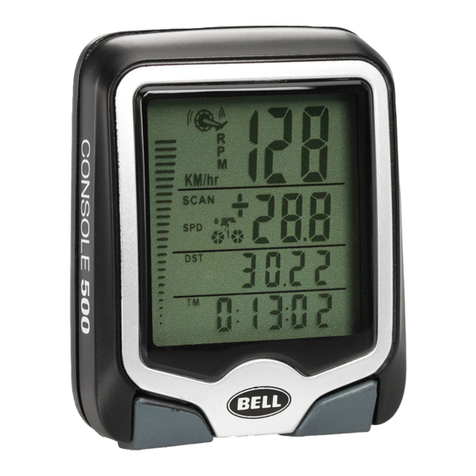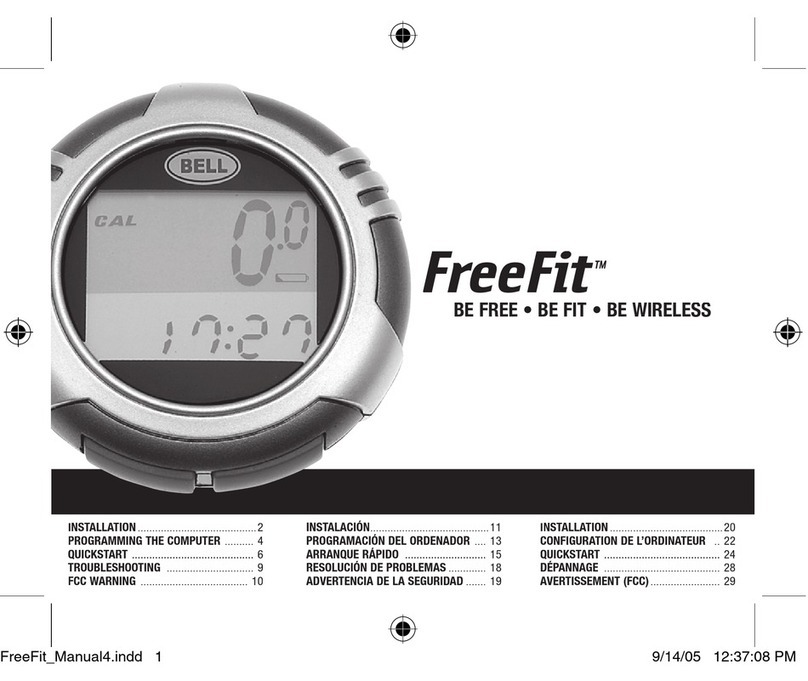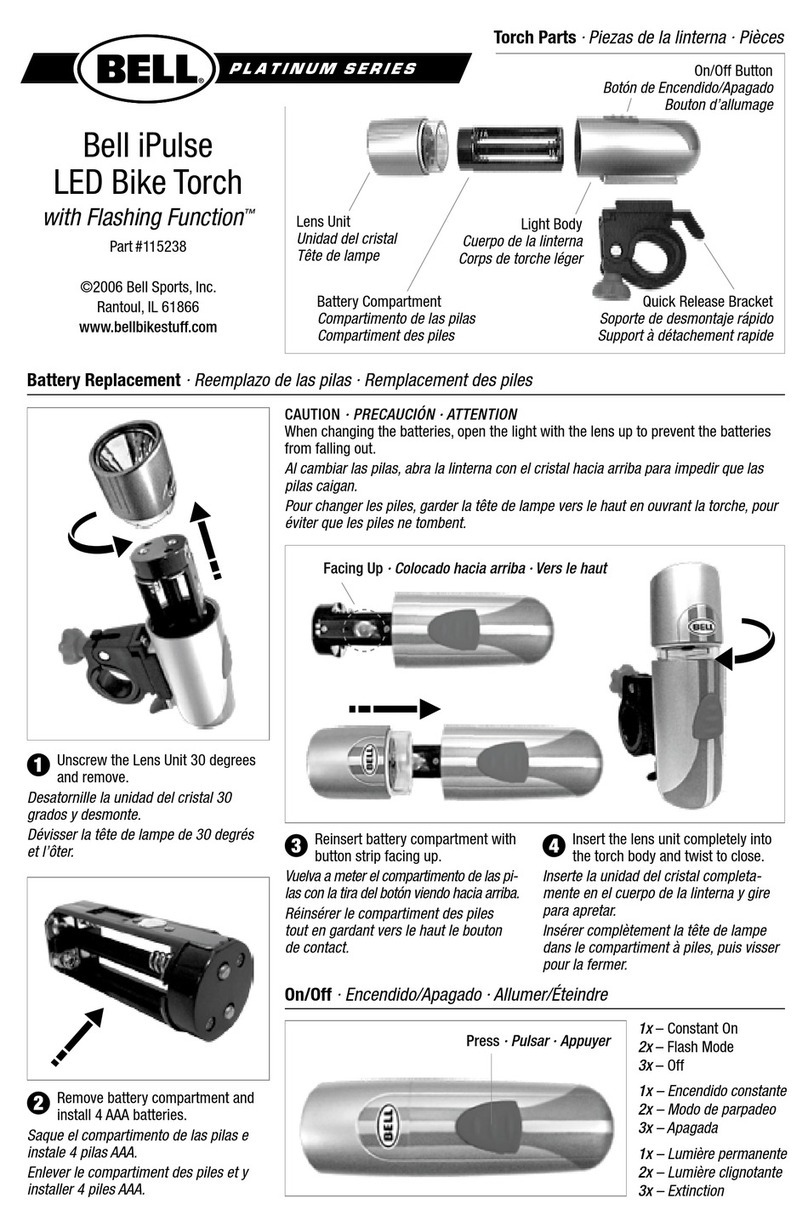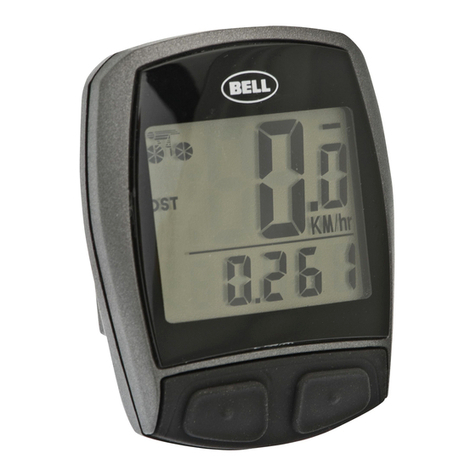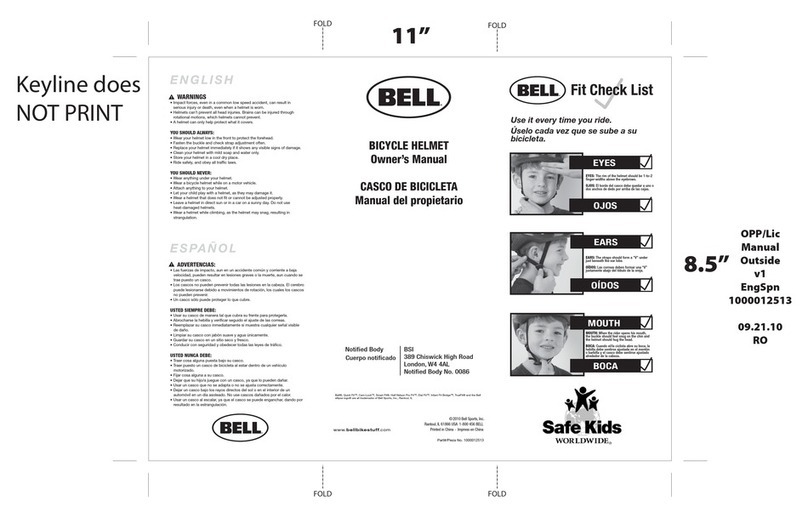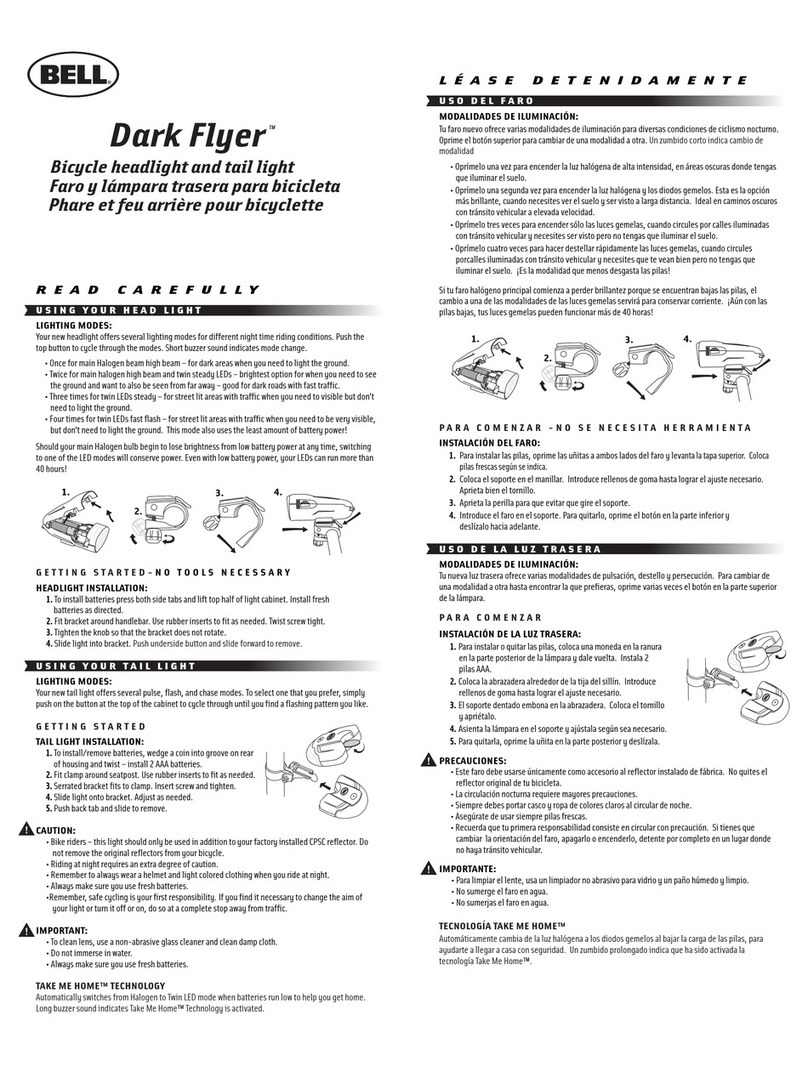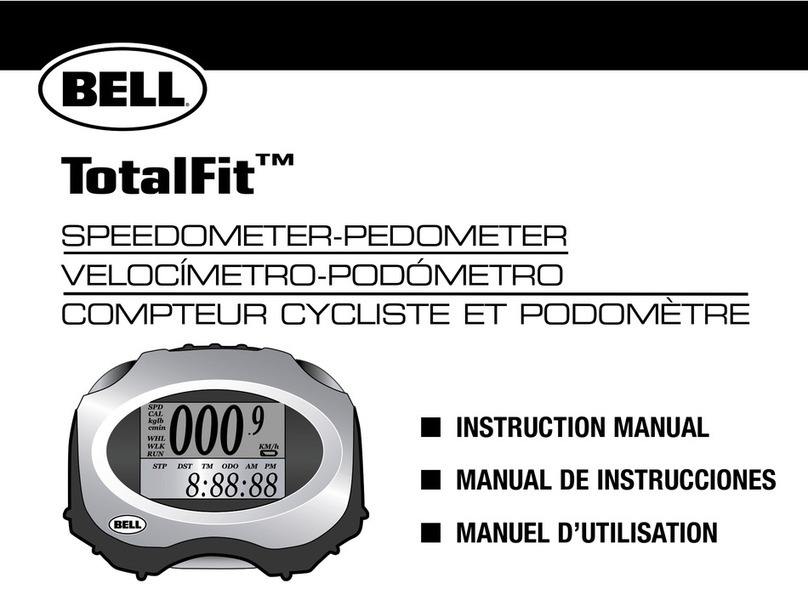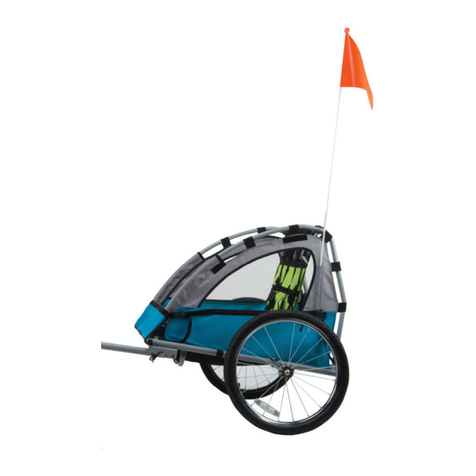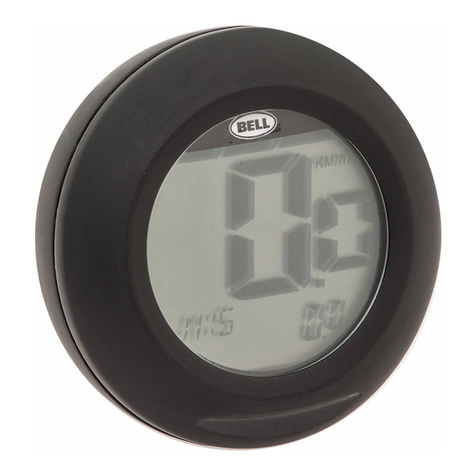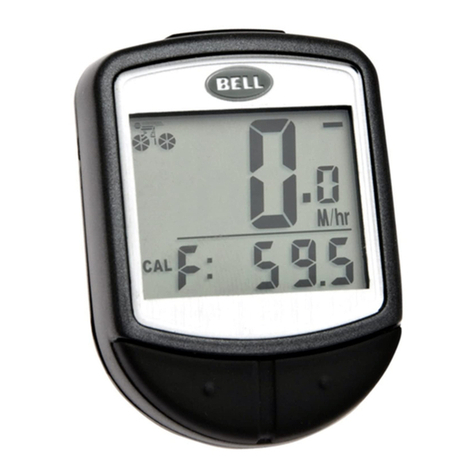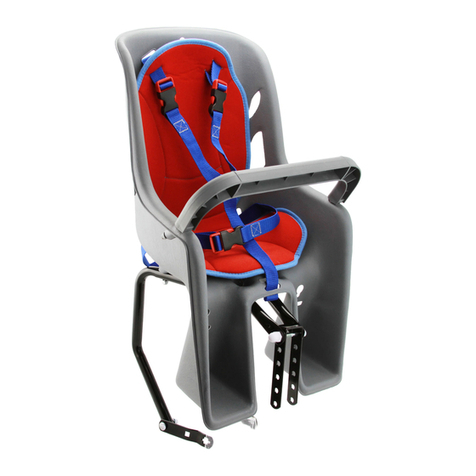11”
8.5”
FOLD FOLD
FOLDFOLD
PROPER FIT IS CRITICAL TO HELMET PERFORMANCE
Helmets that slip to the front, back or side of the head expose parts of the skull.
Loose or unbuckled straps can allow the helmet to completely fall off the head in
an accident. If the helmet cannot be tted correctly, try a different size helmet.
HOW TO FIT A HELMET
1: PUT THE HELMET ON
The rim of the helmet should be 1-to-2 nger-
widths above the eyebrows. The helmet needs
to be low in front to protect the forehead (Fig. 1).
If so, proceed to step 2.
2: SIDE STRAPS
For a correct t, the side straps should join at a point
slightly below and in front of the ears, forming a ‘V’ under the ear lobe (Fig. 2).
3: REAR FIT SYSTEM
Position the helmet on your head so that the elastic t belt is below the bony
protrusion at the back of your head (Occipital Lobe) (Fig. 3).You want the system
to be snug, but not uncomfortable.
4: ADJUST THE CHIN STRAP
Always wear the helmet with the chin strap
buckle fastened and the strap pulled tight. Make
sure the strap is against the throat, NOT on the
point of the chin. Straps worn on the point of the
chin increase the chance of the helmet coming off
in an accident. Figures 4a and 4b show how to
fasten and release the buckle.
Make sure the buckle is ush against the skin under the chin and that when
you open your mouth, it is snug on the chin and hugging your head.
WARNING: Make sure the loose end of the strap
passes through the rubber “O” ring (Fig. 4c). If it
does not, the strap may slide loose and the
helmet can come off accidentally.
5: CHECK THE FIT AND ADJUSTMENTS
Before using the helmet, stand in front of the
mirror and grab the helmet with both hands
and twist it to the left and to the right. If the
helmet ts right, the skin on the forehead will
move as the helmet moves. If it does not, then the helmet is too loose and is
unsafe for use and you need to start over using the steps above. Now grab the
helmet with both hands and try to remove it by rolling the helmet forward and
backward. If you can roll it off the head completely or so far that it blocks vision
or backward far enough to expose the forehead, then it doesn’t t right and is
unsafe for use and you need to start over using the steps above.
6: TAKE A TEST RIDE
Once you are satised that the helmet ts correctly and that all straps are
properly adjusted and tightened, take a short test ride. Pay attention to overall
comfort and helmet stability while riding. Make any minor adjustments to the
t pads and straps to improve comfort or stability.
EARS
MOUTH
EYES
EL AJUSTE CORRECTO ES DE IMPORTANCIA VITAL
EN EL RENDIMIENTO DEL CASCO
Los cascos que se deslizan hacia el frente, la parte posterior o el lado de la cabeza
exponen partes del cráneo. Las correas sueltas o no abrochadas pueden permitir
que el casco se caiga completamente de la cabeza en un accidente. Si el casco no
se puede ajustar correctamente, pruébese un casco de tamaño diferente.
CÓMO AJUSTAR UN CASCO
1: PÓNGASE EL CASCO
El borde del casco debe quedar a uno o dos
anchos de dedo por arriba de las cejas. El
casco necesita quedar hacia abajo sobre la
frente para protegerla (Figura 1). De ser así,
proceda al paso 2.
2: AJUSTE LAS CORREAS LATERALES
Al quedar correctamente, las correas laterales deben unirse en un punto
ligeramente abajo y adelante de las orejas. formando una “V” bajo el lóbulo de
la oreja (Figura 2).
3: SISTEMA DE AJUSTE POSTERIOR
Coloque el casco sobre su cabeza de
manera tal que el sistema de ajuste posterior
(si corresponde) queda debajo de la
protuberancia ósea en la parte posterior de
su cabeza (Lóbulo occipital) (Figura 3).
El sistema debe quedar ajustado pero no incómodo.
4: AJUSTE LA MENTONERA
Use siempre el casco con la hebilla de la correa mentonera o barbillera
abrochada y la correa ajustada rmemente. Asegúrese de que la correa quede
contra la garganta, NO en la punta del mentón o barbilla. Las correas utilizadas
en la punta del mentón pueden incrementar la posibilidad de que el casco se
separe de su cabeza en un accidente. Las guras 4a y 4b muestran cómo
abrochar y soltar la hebilla.
Asegúrese que la hebilla queda al ras contra la piel bajo el mentón y que cuando
usted abre su boca, se siente ajustado contra el mentón y rme sobre su cabeza.
ADVERTENCIA:Asegúrese que el extremo
suelto de la correa pasa por la junta tórica de
caucho (Figura 4c). De no ser así, la correa
puede deslizarse y soltarse y el casco se
puede caer accidentalmente.
5: REVISE LOS AJUSTES
Antes de usar el casco, párese frente al espejo,
tome el casco con ambas manos y gírelo hacia
la izquierda y hacia la derecha. Si el casco está correctamente ajustado, la piel de
la frente se moverá a medida que el casco se mueve. Si no lo hace, entonces el
casco está muy suelto y no proporciona seguridad al usarlo, por lo que necesita
volver a empezar otra vez con los pasos anteriores. Ahora agarre el casco con
ambas manos y trate de quitárselo al girar el casco hacia delante y hacia atrás.
Si el casco se separa de su cabeza totalmente o lo suciente como para taparle la
vista, o hacia atrás hasta dejar despejada la frente, entonces dicho casco no esta
perfectamente ajustado y no proporciona seguridad al usarlo, por lo que usted
necesita volver a empezar con los pasos anteriores.
6: HAGA UN VIAJE EN BICICLETA DE PRUEBA
Una vez que usted está satisfecho/a de que el casco está correctamente
ajustado y que todas las correas están correctamente ajustadas y apretadas,
haga un corto recorrido en bicicleta. Ponga especial atención a la comodidad y
estabilidad del casco mientras viaja en bicicleta. Haga todos los ajustes menores
necesarios a los cojines de ajuste y a las correas para mejorar la comodidad o
estabilidad.
OJOS
OÍDOS
BOCA
All safety equipment has limits. Read this helmet manual
carefully and follow the instructions completely.
Todo equipo de seguridad tiene sus límites. Lea el manual de este
casco cuidadosamente y siga elmente todas las instrucciones.
1.800.456.BELL
WARNING: If you cannot adjust the helmet so that it ts correctly according to these
instructions or so that it is comfortable and stable while riding, DO NOT USE IT. Return it
to your store or contact us for assistance.
1.800.456.BELL
ADVERTENCIA:NO USE ESTE CASCO si usted no puede ajustar el casco para que
quede correctamente ajustado de acuerdo con estas instrucciones o de manera tal que
se sienta cómodo y estable al viajar en bicicleta. Devuélvalo a la tienda donde lo compró
o contáctenos para solicita ayuda.
12
True Fit®
“0” ring
Junta tórica
4a
4b 4c
3
TrueFit
Manual
EngSpn
Inside
v1
10000012512
09.21.10
RO
Keyline does
NOT PRINT
